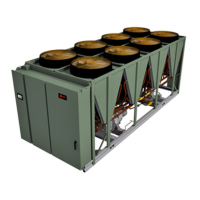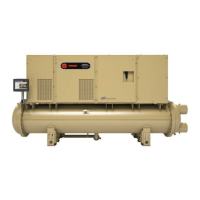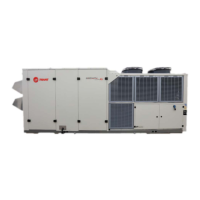AC-SVX003A-EN
97
Free-Cooling Coil
Free-Cooling Coil Cleaning
Regular coil maintenance enhances the unit's operating
efficiency by optimizing free-cooling heat transfer and
amperage draw. The free cooling coil should be cleaned at
minimum once each year, or more if the unit is located in a
dirty or corrosive environment.
Free-cooling coil cleaning process is the same as
condenser coil cleaning.
Free-Cooling Fluid Management
NOTICE
Equipment Damage!
Failure to follow instructions below could result in
equipment damage.
DO NOT USE UNTREATED WATER. Glycol solution
must be utilized with the Direct Free Cooling options
and in the free cooling loop of Indirect Free Cooling
options. Glycol percentage should be based on freeze
avoidance requirements. The glycol solution requires
an inhibitor package to be carefully chosen with the
aid of qualified water treatment specialist to abate
corrosion in a mixed metal system.
The building glycol loop should not be vented to
atmosphere. A closed system is required to limit
oxidation potential within the loop.
Make-up water should be avoided.
NOTICE
Coil Damage!
Failure to follow instructions below could result in
free-cooling coil freeze.
For units with free-cooling option, introduction of
uninhibited water into the system is not
recommended, as it could lead to internal corrosion
and risk of coil freeze. To avoid free-cooling coil
damage:
• If the building loop needs to be charged with
water for testing purposes, isolate free-cooling
coils by closing free-cooling service shut-off
valve and modulating valve.
• Completely drain any water inadvertently
introduced into the system, and replace with
glycol fluid as required for the free-cooling
system.
• If water was introduced for hydronic testing,
and was not immediately replaced with glycol
solution, a glycol (freeze inhibitor) solution
must be introduced to the free-cooling system/
coils for any long term storage.
The free cooling option circuit consists of copper, carbon
steel, cast iron, zinc, EPDM rubber, brass, and Aluminum
AA3102, AA3003, AA4045. Direct free cooling units will
also have the addition of other materials that may be in the
building loop connected to the chiller. An inhibitor is
required in the glycol/water system to passivate metal
surfaces and decrease the corrosion rate. The
effectiveness of a corrosion inhibitor depends on the fluid
composition and quantity of water. Avoid system fluid
dilution and ensure a level of reserve alkalinity is
maintained. Glycol fluid should be free from foreign solid
particles. A maintenance schedule should be selected per
the glycol manufacturer’s requirements to insure adequate
protection during product usage.
Reinstallation of Compressor
Mounting Bolts
Units with InvisiSound™ Ultimate Only (Model Number
Digit 13 = E)
If compressor removal or unit move is required on a unit
with InvisiSound™ Ultimate option, reinstall compressor
mounting bolts which were removed per installation or
maintenance instructions.
Servicing Chiller Roof
WARNING
Do Not Climb on Top of Unit!
Failure to follow these instructions could result in
technician falling off the equipment which could
result in death or serious injury.
Do not climb on roof to service unit. Use service tools
designed to access top of chiller.
Service tools are available to access top of chiller. Entry on
chiller roof is not required.
Maintenance

